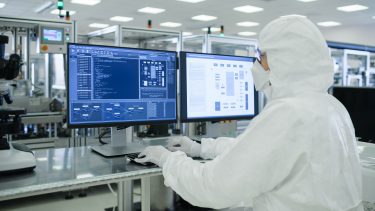From inception to conclusion: how digitalisation is impacting drug development
Posted: 3 July 2020 | Phoebe Chubb (freelance author) | No comments yet
Phoebe Chubb explores how digitalisation is shaking up the world of drug discovery and development by increasing productivity and reducing human error.


Advances in software and technology continue to shake up pharma
It is widely acknowledged by many working in drug discovery and development that digital solutions have an integral role to play in ensuring that speed, productivity and accuracy increase in pharma. With the growing global adoption of enabling technologies, the pressure has been put on laboratories to digitalise, in order to ensure that not only drug turnover is quickened but also that pharmaceutical laboratories remain both profitable and competitive in an ever-changing global market. The transformation of this environment is inevitable and with this radical change comes many possibilities, not just for the healthcare industry, but for science and researchers as a whole.
Opportunities offered


The future of drug discovery and development lies in the digital world, yet, until recently, studies have shown that the pharmaceutical industry has fallen behind the digital trend despite the substantial number of benefits digital technologies offer it.1 With many aspects of drug discovery and production dependent on innovation (scientific breakthroughs) lagging behind in digital progression, as Mckinsey points out seems “counterintuitive”1 and to some extent damaging. Laboratory digital solutions have been shown to significantly reduce the complexity and costs of drug development, from the research laboratories to the supply chain, execution and manufacturing aspects of pharma.
As noted in Science Direct’s article titled “Drug Development”, traditional drug development processes suffer from a “high attrition rate”. Every new drug brought to the market will have had vast amounts of time and effort invested, along with substantial financial costs outlined here by Hill: “lead compound discovery research is also costly and time-consuming, taking by some estimates over five years and more than $200 million, not including the even more substantial time and costs associated with drug development”.2 Implementation of software and technological innovation into this environment is being hailed as the key to achieving a greater level of efficiency in drug development. The path of digitalising does not come without challenges, yet in the majority of cases, this is offset by the number of opportunities it brings to the industry. So far, its implementation has been seen largely as a success, with studies3 attributing increases in productivity to digital software’s ability to streamline complex processes and connect the laboratory environment. An increase in productivity in the laboratory could subsequently lead to quicker drug development, which will in turn help researchers tackle future threats to public health.
Digital Technologies
Whilst some have already started the process of digitalisation, switching from a paper lab notebook to an electronic laboratory notebook (ELN; a digital platform which enables all research data to be accessible from anywhere with internet connectivity); even this can and should be taken further. In recent years there has been a growing emphasis on ‘the Internet of Things (IoT)’ which involves the combination of automation and monitoring in specific environments, you’ve probably heard of Smart Homes and Cities but perhaps not the Smart Lab. A Smart Lab is a laboratory made more unified through the addition of disruptive technology like automation and AI. Considering its ability to increase efficiency, accuracy and replicability in the laboratory, many have suggested that this could be the key to improving productivity in the drug development industry, not only in terms of the research laboratories but also to be used in the execution and distribution elements of pharma. Automation is often viewed to be an expensive solution; however, despite initial expense, automation has been demonstrated to be a more financially viable solution in the long run. It comes in a number of forms, such as the laboratory information management system and the Laboratory Execution System, among others. The advantages of these tools include increased productivity and the reduction of human error, which has proven to be one of the most problematic barriers to overcome in scientific research.


The connective opportunities automation facilitates allow scientists to directly receive results from machines, removing repetitive tasks which is one of the most draining aspects of life as a researcher. By maximising the abilities of automation, laboratories can significantly reduce the need to repeat experiments due to qualms over human error and science, as a result, will progress at an even greater rate. Automation also seeks to connect laboratory processes with the ability to control devices remotely, it offers scientists a flexible approach to conducting experiments, which is certainly advantageous, particularly in challenging times like we face today.
Conclusions
Digitalisation can be costly, but the long-term benefits from implementing innovative solutions are apparent, especially in environments like the laboratory, with many studies hailing innovation of the pharmaceutical industry as a key step towards ensuring smarter laboratory processes. This technology not only saves a researcher considerable time and effort, (through the reduction of repetitive tasks); but it also facilitates other aspects of the drug discovery and development industry. Digital accessibility provided by ELNs will allow scientists to have greater oversight and control over their experimental data, along with helping them with compliance and data traceability. The combined features of these digital technologies are expected to fuel a new wave of groundbreaking discoveries, making humanity better equipped to tackle challenges we will inevitably face in the years to come.
About the Author
Phoebe Chubb is freelance writer who specialises in the implementation of IoT and other enabling technologies into the laboratory environment. She has published a number of articles on high profile sites such as Hackernoon, IoTforall, The Pie Blog and many more. In her articles she addresses the importance of digitalisation in research and development, highlighting the pivotal role it plays in ensuring scientific advancement.
References:
- Leclerc, O. and Smith, J. How new biomolecular platforms and digital technology are changing R & D [Internet]. McKinsey & Company. July 2018. [Cited: June 2020] Available at: https://www.mckinsey.com/industries/pharmaceuticals-and-medical-products/our-insights/…
- Rang, H. and Hill, R. Drug Discovery and Development (Second Edition), 2013
- Han, Y., Makarova, E., Ringel, M. and Telpis, V. Digitization, automation, and online testing: The future of pharma quality control [Internet]. McKinsey & Company. January 2019. [Cited: February 2020] Available at: https://www.mckinsey.com/industries/pharmaceuticals-and-medical-products/our-insights/…








